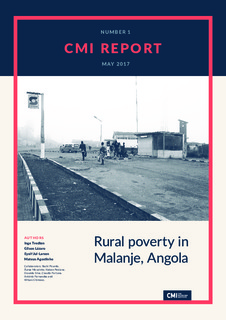| dc.description.abstract | This report is part of the research programme “Cooperation on Research and Development in Angola” between Centro de Estudos e Investigação Científica (CEIC) at the Catholic University in Luanda, Angola and Chr. Michelsen Institute (CMI) in Bergen, Norway. The objective of the programme is to increase the quality, quantity and availability of relevant research-based knowledge on Angola. The programme has several sub-projects in political science, economics and social science. This report on rural poverty in Malanje is related to the social science sub-project “Urban and Rural Poverty Dynamics”, and will be followed by a similar report on urban poverty in Luanda (forthcoming 2017).
Doing social science research on poverty and inequality in Angola is challenging. There is a dearth of aggregate statistical data showing the distribution of poverty over space and time, and there are practical hindrances at the local level ranging from lack of experience of being subject to studies of this nature to logistical problems in implementing data collection. This project has been based on a combination of the limited aggregate quantitative data that exist, and the collection of quantitative and qualitative primary data in carefully selected urban and rural sites centred on a ‘Reality Check’ approach.
1.2 Poverty in Angola
Existing aggregate information indicate that despite high economic growth the past couple of decades, poverty in Angola is severe. Angola’s ‘official’ poverty rate is 36.6 percent, with 18.7 percent for urban and 58.3 percent for rural areas (INE 2013; see also Vidal and de Andrade 2011). However, scholars and commentators argue that that the figures are too low and conceal considerable variations between and within different provinces and urban and rural social formations. The most common proxy for multidimensional poverty, the under-five/child mortality rate, has seen some imp | |
